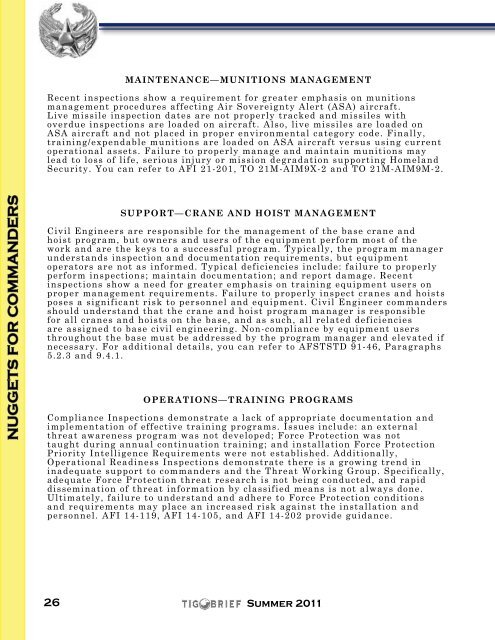tig brief - Air Force Inspection Agency
tig brief - Air Force Inspection Agency
tig brief - Air Force Inspection Agency
Create successful ePaper yourself
Turn your PDF publications into a flip-book with our unique Google optimized e-Paper software.
NUGGETS FOR COMMANDERS<br />
MAINTENANCE—MUNITIONS MANAGEMENT<br />
Recent inspections show a requirement for greater emphasis on munitions<br />
management procedures affecting <strong>Air</strong> Sovereignty Alert (ASA) aircraft.<br />
Live missile inspection dates are not properly tracked and missiles with<br />
overdue inspections are loaded on aircraft. Also, live missiles are loaded on<br />
ASA aircraft and not placed in proper environmental category code. Finally,<br />
training/expendable munitions are loaded on ASA aircraft versus using current<br />
operational assets. Failure to properly manage and maintain munitions may<br />
lead to loss of life, serious injury or mission degradation supporting Homeland<br />
Security. You can refer to AFI 21-201, TO 21M-AIM9X-2 and TO 21M-AIM9M-2.<br />
SUPPORT—CRANE AND HOIST MANAGEMENT<br />
Civil Engineers are responsible for the management of the base crane and<br />
hoist program, but owners and users of the equipment perform most of the<br />
work and are the keys to a successful program. Typically, the program manager<br />
understands inspection and documentation requirements, but equipment<br />
operators are not as informed. Typical deficiencies include: failure to properly<br />
perform inspections; maintain documentation; and report damage. Recent<br />
inspections show a need for greater emphasis on training equipment users on<br />
proper management requirements. Failure to properly inspect cranes and hoists<br />
poses a significant risk to personnel and equipment. Civil Engineer commanders<br />
should understand that the crane and hoist program manager is responsible<br />
for all cranes and hoists on the base, and as such, all related deficiencies<br />
are assigned to base civil engineering. Non-compliance by equipment users<br />
throughout the base must be addressed by the program manager and elevated if<br />
necessary. For additional details, you can refer to AFSTSTD 91-46, Paragraphs<br />
5.2.3 and 9.4.1.<br />
OPERATIONS—TRAINING PROGRAMS<br />
Compliance <strong>Inspection</strong>s demonstrate a lack of appropriate documentation and<br />
implementation of effective training programs. Issues include: an external<br />
threat awareness program was not developed; <strong>Force</strong> Protection was not<br />
taught during annual continuation training; and installation <strong>Force</strong> Protection<br />
Priority Intelligence Requirements were not established. Additionally,<br />
Operational Readiness <strong>Inspection</strong>s demonstrate there is a growing trend in<br />
inadequate support to commanders and the Threat Working Group. Specifically,<br />
adequate <strong>Force</strong> Protection threat research is not being conducted, and rapid<br />
dissemination of threat information by classified means is not always done.<br />
Ultimately, failure to understand and adhere to <strong>Force</strong> Protection conditions<br />
and requirements may place an increased risk against the installation and<br />
personnel. AFI 14-119, AFI 14-105, and AFI 14-202 provide guidance.<br />
26 Summer 2011


